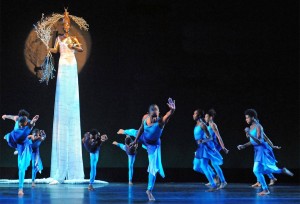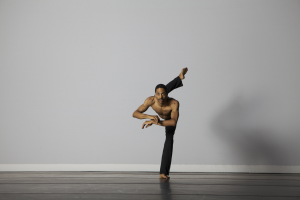Back in 1991, when Tony Award-winning choreographer Garth Fagan first teamed with jazz composer Wynton Marsalis, Fagan gave Marsalis a poem he had written in the voice of a West African storyteller to use as a centering theme for the music of “Griot New York.” The juncture of these two revered artists made for soaring, warmth-spreading dance-theater.
After a 21-year gap, the two artists met up again two years ago. Fagan’s trust in Marsalis – and “the process,” Fagan explained in a recent phone interview from Rochester, NY – had grown to the point where he gave the Grammy Award winner just a single phrase for inspiration, based on some words he’d recently introduced to his great-grandson.
“Lighthouse/Lightning Rod” (2012), named for that seminal phrase, debuts in L.A. this week at the Nate Holden Center, and looks to be another sublime blending of Marsalis’ loose and searching melodies with Fagan’s perfectly pitched, humanistic dance expression.
In what was likely the riskier move, Fagan uttered those same three poetic words to Los Angeles artist Alison Saar when he commissioned her set design. This unusual long-distance trust was built from Fagan’s lasting connection – a Saar sculpture called “Inheritance,” a bronze, 6-inch little girl with a tangled white ball on her head that he first saw years back in a Rochester art gallery.
“I lost a daughter at 2 years and 10 months old,” Fagan explained, “and that took me years to get over, and I’m still not over it. (So when) I saw (Saar’s) little girl, I fell madly in love with it, and I bought it instantly. … This little girl, she is so courageous, and so beautiful, and so strong, and whatever they hurl at her, it doesn’t matter. She will never be a victim.”
From Saar, Fagan expected something abstract, maybe asymmetrical. “All I told her was the title of the piece,” Fagan said, “‘Lighthouse/Lightning Rod’ – because one saves and guides, and another saves and guides too, but they’re two different things, two different environments.” When Saar delivered the lighthouse as a giant female figure holding branches, Fagan found it be “the most beautiful lighthouse you have ever seen. … What else would draw a sailor to the shore but a beautiful woman?” … It was all her idea, we had no discussion. I will forever thank her.”
Acclaimed costume designer Mary Peterson, who worked with Fagan on “The Lion King,” created the water- and sky-colored costumes for “Lighthouse/Lightning Rod,” but “at a price we could afford,” Fagan said, chuckling, “not at Broadway prices.”
Given Fagan’s artistic endurance and infectious good humor, the passing of time feels to be a pure celebration, a journey where small bronze girls blossom into fierce female beacons. Next year is a big one for the troupe: Fagan turns 75, his company turns 45, and his school turns 25.
And as the years pass, Fagan’s company continues to break molds. Originally, the movement fusion of classic modern mixed with Afro-Caribbean and ballet dance – set to Fagan’s keen, personal choreographic tempo – was a rare delight. These days his company is also enhanced by the continuing stage presence of some of Fagan’s most celebrated dancers, like Steve Humphrey, 62 (who danced in Fagan’s very first show), and Bessie Award winners Norwood Pennewell and Natalie Rogers. Of Humphrey, Fagan spoke honestly and reverently. “There are some things he can’t do anymore, and it’s not appropriate for him to do. But boy, there are some things he can lay out in spades.”
At the same time, Fagan continues to seek out young dancers with both technique and naturalism, following some for years before they’re ready to join the company, like featured dancer Vitolio Jeune. He also likes challenging the women to fly as high or higher than the men. “I love the kids,” Fagan said, “they jump and they bound, and they do all the stuff that kids do. But in opera, in drama, in music, we have older voices and people with some age and experience behind the note. And to my taste, age and experience can be more subtle, and more painful if necessary, and more exalting if necessary.”
It satisfies him, and reflects his own path, to look at a dance stage and “see a community of people, all the ages that make up our wonderful lives.”
Along with “Lighthouse/Lightning Rod,” which runs about 30 minutes in Fagan’s condensed touring version, the troupe is bringing an older company favorite, “Prelude,” plus a more recent work, “No Evidence of Failure,” set to jazz by Monty Alexander, featuring a solo for Rogers as well as an honest, intense relationship between Rogers and young Jeune.
“You don’t see wonderful relationships with people of color too much on American stages,” Fagan said. “You always see a lot of the ‘Come here, bitch’ dances. And sure, we have that in our race. White races have it too. But we also have lots of wonderful, nourishing relationships with care, and husbands who take care of their wife and children, and I wanted to put that on stage. And this is what this is.”
“I have one rule — that my studio is a sacred place,” He said. ” So whatever dramas and traumas you’re going through, leave them by the elevator. Don’t bring them in with you. Because if you want to hear bad news, I can give you 24/7 about it, especially with funding and everything being what it is these days. And I don’t bring it in here, we bring this as a place to work and nourish and celebrate. And I like that about my concerts too, that people see the work, the nourishment and the celebration. And they get new ideas, things they never thought up before, or things they need to rethink. Because we all think we have solved certain problems in life, and we really haven’t.”
The program also features selections from “Gin,” featuring new choreography by Pennewell, who also serves as company rehearsal director these days.

